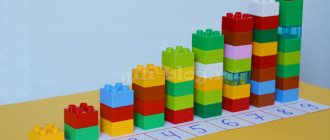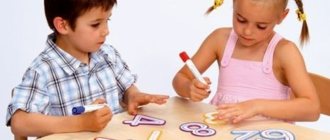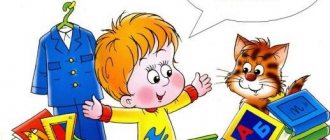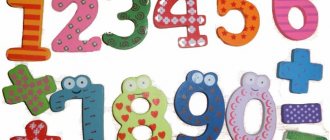You need to teach something when a question arises. Children are sent to kindergarten at the age of three. By this time, it is useful to teach your child the names of the days of the week. If the baby distinguishes Monday from Friday, it will be easier for him to get used to it. He will know when the long-awaited weekend comes. The very concept of a weekend arises only after entering kindergarten. It is easier for a child to integrate into the seven-day rhythm of adults and socialize. So by this time, parents need to know how to teach their child the days of the week.
If a preschooler is raised at home, the problem of learning is not so acute. You can wait until the baby himself asks: “Why was daddy at home yesterday and left today?” Such a question will not arise later than 4-5 years, the age of why. But by the age of 5-6, a preschooler should know the names of the days of the week, relate them to life, that is, understand that today is Wednesday.
What you need to know to learn the days of the week
- The child must be able to count to 10.
- The baby must understand what “day” and “night” are, that after night comes the next day.
- Abstract thinking must develop so much that the child can separate yesterday, today and tomorrow. Usually every adult's memories contain the moment of this realization. If a baby wakes up on a dark winter evening and says “yesterday” about morning time, then parents should think about how to teach their child the days of the week.
Preparatory group
For preschoolers aged 6-7 years, more complex educational games are provided that develop logic and thinking abilities.
Hide and seek
Tell the students that the days of the week wanted to play hide and seek. But there is a hint that allows you to quickly find them. Each of them hid behind an object or in a room whose name begins with the same letter as the day. Name this object, and the children must guess the day.
For example:
- hid behind the desk... Monday;
- behind the hanger... Tuesday;
- behind the bench... Wednesday;
- in the attic... Thursday;
- in the hallway... Friday;
- behind the chair... Saturday;
- in the bathroom... Sunday.
Say the word
To play you need a ball. Throw it to the players one by one, asking questions like this:
- on Monday mom works, and on Sunday... she rests;
- Wednesday is followed by... Thursday;
- Tuesday is today, and Wednesday is... tomorrow;
- Today is Friday, and yesterday was... Thursday.
Where to begin
- Reinforce the concepts of day, night, yesterday, today, tomorrow . To do this, start asking questions before going to bed: “What interesting happened today? What discoveries will we make tomorrow? And in the morning, on the contrary, ask: “What did you eat before going to bed yesterday?” Focus on pleasant events that happened yesterday or will happen tomorrow.
- Enter the concepts of the day before yesterday and the day after tomorrow . The child must realize that he needs to jump over the day. Use new words only together with familiar ones: tomorrow and yesterday, day and night. Say: “Tomorrow it will be cold, and the day after tomorrow it will be warm again.”
- Some advanced parents use such rarely used words as the day before yesterday and the day after tomorrow. But the majority will still say “in three days.”
How to teach your child the days of the week
- Divide your days into weekdays and weekends. Wait for the question and identify the problem. For example, you send your child to kindergarten, and he asks how many days he needs to go. It is necessary to explain that there are seven days in a week: 5 working days, 2 days off. Just don't be too categorical. There are children who believe that a day off is a law of nature, no one goes to work, and salespeople, teachers, and other working adults are very similar robots. It would be correct to explain that Saturday and Sunday are days off for many, but doctors and firefighters work.
- Learn names in a playful way, as described below.
- You can tell a sensible child about the meanings of the days of the week. After the week (Sunday in Old Russian), Monday began. That is, during the week (Sunday) we didn’t do any work and rested. Second in line is Tuesday. The next day is in the middle. Thursday and Friday from the numbers. Saturday - in the language of the Bible, rest, rest. The child does not need to know the details. If children go to the Orthodox Church, tell them that in Rus' the week (or week in the church) began on Sunday, which, in turn, began to be celebrated on Saturday evening. That is, Saturday was the seventh, holiday day.
- An educational cartoon is suitable for busy (uncreative) parents. For example, “Tralik and Roller”, “Locomotive Chukh-Chukh”. But parents are not involved in teaching, which is bad. Therefore, it is better to watch cartoons with your child, comment on it, and then discuss the plot.
- Even if you don’t make any special efforts, but just name the day of the week every morning, your baby will be able to quickly remember everything.
Goals and objectives
The goals of didactic games are the formation of ideas about time, which fits within the framework of the week, and the consolidation of time terms.
Tasks:
- developing the skill of sequentially listing days;
- learning to distinguish between temporary concepts “today”, “yesterday”, “the day before yesterday”, “tomorrow”, “the day after tomorrow” and others;
- formation of the idea that the week is divided into working days and weekends;
- fostering curiosity and respect for the world around us;
- strengthening the skills of productive teamwork, fostering friendliness and perseverance.
Visual aids and games for learning the days of the week
- Regular wall calendar. Names must be written in full and in capital letters. This way, even the smallest child will remember how to write such complex words. This is also suitable for a child who does not know letters (there is a way to teach reading whole words).
- A seven-flowered flower that you can draw, decorate and name each petal a day of the week.
- Seven dwarves or seven heroes (depending on which fairy tale you are raising your child on). You can take a picture from a book or a coloring book and sign the day of the week for each gnome or hero.
- Toys consisting of segments. Methodists recommend taking a train with seven carriages of different colors, each named: Monday, Tuesday…. A train can play the role of a calendar: in the morning, move your favorite toy to another carriage. Ask questions: “Show everyday life; find Saturday; What color is Thursday?
- The role of a homemade weekly calendar can be played by anything, for example, seven vases or seven dolls. It is better if there are girl dolls and boy dolls, because there are men's and women's days, and Sunday is neuter, it can be designated by a doll. Think about how you will depict the days of the week. For example, you can put a red riding hood on the doll whose day it is, put a toy pie in front of it, etc.
- Make a clock that shows the day of the week. Make a cardboard clock, divide it into 7 segments and attach a movable hand. This design will help you learn to use the clock more easily in the future, just write the words clockwise.
- Together with your child, make colorful drawings that symbolize the seven days of the week, for example, a rainbow, a flower, pencils in a box, trailers, houses. Each day has its own color.
- Read or learn poems about the days of the week by Mikhalkov, Stepanov, Usachev and other children's authors, proverbs and sayings. Use poetry at the stage of consolidating the material. For example, this poem.
One two three four five. Let's call it weekdays. Monday is the first day, It is the beginning of all weeks. Tuesday is the second day, it is always before Wednesday. In the middle is Wednesday, always smiling. And the fourth day is Thursday, there is a lot to do, right up to the top. The fifth Friday is coming, it leads to the weekend. Day six is Saturday – We don’t go to work. Sunday - the seventh day - Either lie down or sing a song. Count the days of the week and start over.
- Rhyme the days of the week with other words to create a vivid image: Monday - slacker, Sunday - salvation, Saturday - care...
- Associate the day of the week with an activity or omen that is different from the activities and omen on other days. For example, on Monday we buy groceries for the week, on Tuesday we play the piano, on Saturday we can go to bed after 9 o’clock, on Sunday we watch cartoons.
The days of the week can be learned easily and with pleasure by communicating, imagining and playing. Do not cultivate prejudices in children, then they will grow up happy. Don't tell them that Monday is hard and Sunday goes by very quickly. Teach your children to enjoy every day.
Didactic games “Days of the week” in the senior group
We present games for 5-6 year olds. Preschoolers learn to name the days in the correct order. With the help of games, they develop an idea of the names of days, time terms, the basic palette, and the skill of ordinal and quantitative counting.
Didactic game “Live Week”
To play, prepare cards with numbers from 1 to 7 and an upbeat musical composition. There are two game options:
- Give cards to students. Turn on music that the children run and dance to. As soon as the music stops, players must line up in the order corresponding to the week. Each child in the row names their day. Next, the children exchange cards and the game continues.
- Divide the students into groups, each with 7 people. Designate a table for each group. Place the cards on the tables so that the numbers shown face down. Each card has its own color. Turn on the music to which the players run and dance. When the music stops, the children run up to their tables, grab a card, see what number they got, and line up accordingly.
Magic flower
To play, cut out a cardboard flower with 7 petals. Each petal has its own color, corresponding to the rainbow palette. Show the flower to the students, tell them that it is magical, because only magical flowers have all the petals of different colors. Ask students to count how many petals there are. When the children answer “seven,” ask them to remember what else happens in such quantity. If the players are at a loss, hint to them that the rainbow has 7 colors and there are 7 days in a week.
Next, the game is built step by step:
- Ask the children to name the days of the week in the correct order. At the same time, point your finger at the petals one by one.
- Bend one of the petals without the players noticing. Children must figure out which color has disappeared and name the corresponding day of the week.
- Point to the petals and ask them to name the neighboring ones. For example, when pointing to “Tuesday” and asking “and tomorrow...” children should answer “Wednesday.” Or: “Friday, and yesterday... Thursday.”
Gnomes
For the game, prepare images of 7 funny gnomes; their caps should be rainbow-colored and close to a certain geometric shape: triangle, circle, square, rectangle, oval, hexagon, trapezoid. Also make from cardboard 7 geometric shapes corresponding to the caps and an image of a house with 7 doors in rainbow colors.
The game is played in 4 variants:
- Line up the gnomes. Call them the days of the week. When the students close their eyes, hide one figurine. Opening their eyes, the children say which day disappeared.
- When the players close their eyes, switch the gnomes' places. Having opened their eyes, children place the figures in the correct order.
- Place geometric shapes in front of the children. Ask to choose a figure suitable in shape and color for each gnome cap.
- Show the players a picture of a fairytale house. Ask them to name which door each gnome should go through.
Fun week
To play, make a circle out of cardboard and divide it diagonally into 7 parts. Color each part in a different color of the rainbow and write the corresponding number. Also cut out two images of bees: one is working, flying with nectar, the second folded its wings to rest. Attach magnets to the back of the bees and the week circle.
The game lasts a week. Every day, when children come to kindergarten, they move the bees to the appropriate day. Moreover, a working bee must be shifted only on weekdays, a resting bee - on weekends. The goal of the game is to form in preschoolers an idea of working days and weekends.








